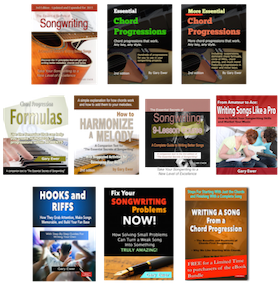Time is the one thing all music has in common. Whether we’re talking about a symphony, a pop song, a jazz ballad — whether it’s hip hop, ska, r&b — all music takes time. A start, a middle, and an ending.
When we’re writing a song, we’re (either consciously or subconsciously) always considering some aspect of a time element. It’s not just about that chorus hook: it’s about how long it took to get to it. It’s about how long the song is. It’s about how melodies, chords and lyrics transform over time.
 “How to Harmonize a Melody” shows you, step by step, how to choose the chords that will work with your melody, how to substitute chords, and how to make more complex progressions work for you. Buy it separately, or as part of “The Essential Secrets of Songwriting” 10-eBook Bundle.
“How to Harmonize a Melody” shows you, step by step, how to choose the chords that will work with your melody, how to substitute chords, and how to make more complex progressions work for you. Buy it separately, or as part of “The Essential Secrets of Songwriting” 10-eBook Bundle.
How a song progresses and changes over the 4 minutes or so of its life is crucial to its success. But when trying to analyze problems with your songs, it can sometimes serve you well to take the time component out and look at the various bits as entities that exist outside of time. Here’s how you might do that with song melodies.
A good song to use to describe this notion of ignoring the time aspect of music would be “On My Mind” — Ellie Goulding’s 2016 hit written by Goulding, Max Martin, Savan Kotecha, and Ilya Salmanzadeh.
In this song, we get four melodies: verse, pre-chorus, chorus and bridge. As you write this kind of song, you want to be sure that there’s a nice build as the song progresses — a nice ebb and flow. But ebb and flow is a time-related quality; forget that for the moment, and just look at the contour of your various melodies (represented by the orange lines below):

Pulling these melodies out of time and just looking at them as musical constructs makes it a lot easier to see their basic architecture. And you can see one thing right away: the obvious similarity between the verse and chorus melodies.
That kind of similarity would only be a problem if it existed in a song in verse-chorus design (i.e., no pre-chorus or bridge). Contrast is a vital part of musical success, so a verse and a chorus that both dwell on a repeated pitch with an upward turn at the end would spell disaster for most songs.
But pulling the melodies out of time and looking at them as separate entities allows you to more easily compare them. You’ll see right away that this kind of song is a prime candidate for adding a pre-chorus that starts with an upward leap, a melody that takes on a completely different shape.
And it’s also a prime candidate for a bridge section that uses a melody with much more contour.
As you can see, you don’t need to be able to read music to make these kind of contour drawings of your song melodies. This is all you need to do: create line drawings of the various melodies you use, and then examine them for similarities and contrast. And it works for any genre of music.
Adjacent sections that use similar melodic shape can bore an audience, so sketching out melodies in this way can alert you to needing to add miscellaneous sections that inject a bit of contrast.
Written by Gary Ewer. Follow Gary on Twitter

 Do you simply need some chords to get you started? “Essential Chord Progressions“, and “More Essential Chord Progressions” are part of “The Essential Secrets of Songwriting” eBook Bundle packages. Hundreds of chords to use as is, or modify to better suit your songs. Get today’s Deluxe Bundle Deal
Do you simply need some chords to get you started? “Essential Chord Progressions“, and “More Essential Chord Progressions” are part of “The Essential Secrets of Songwriting” eBook Bundle packages. Hundreds of chords to use as is, or modify to better suit your songs. Get today’s Deluxe Bundle Deal










